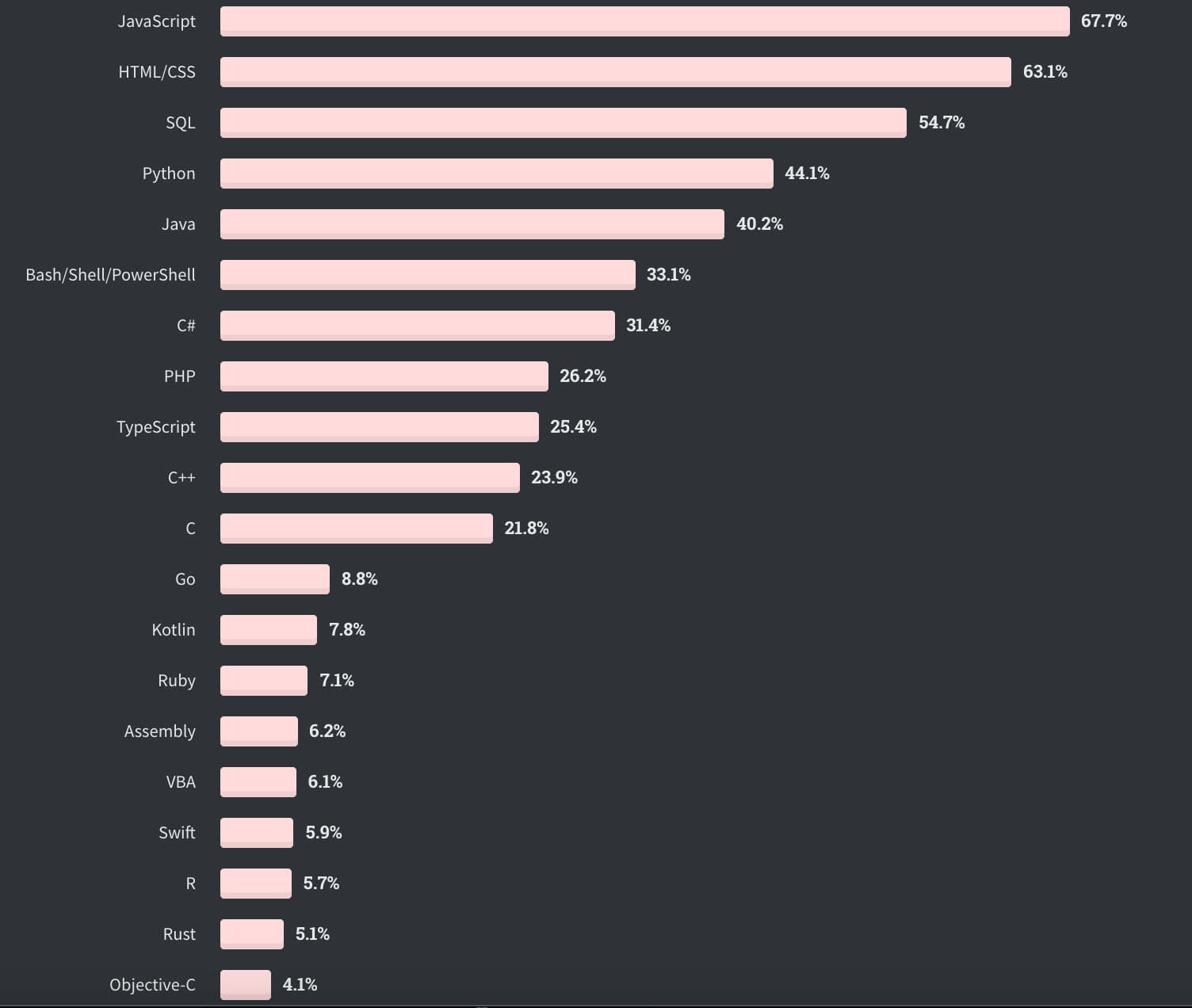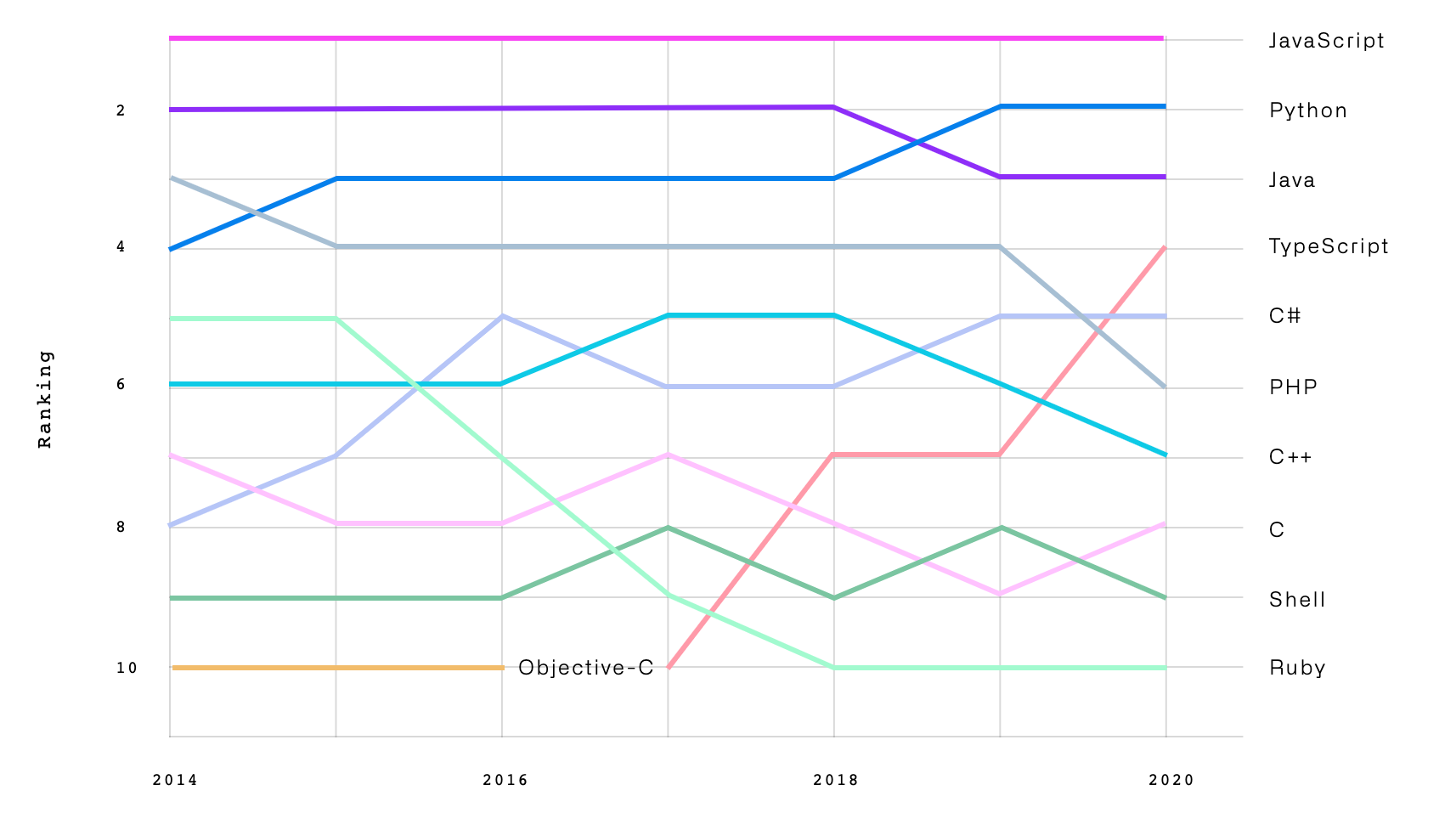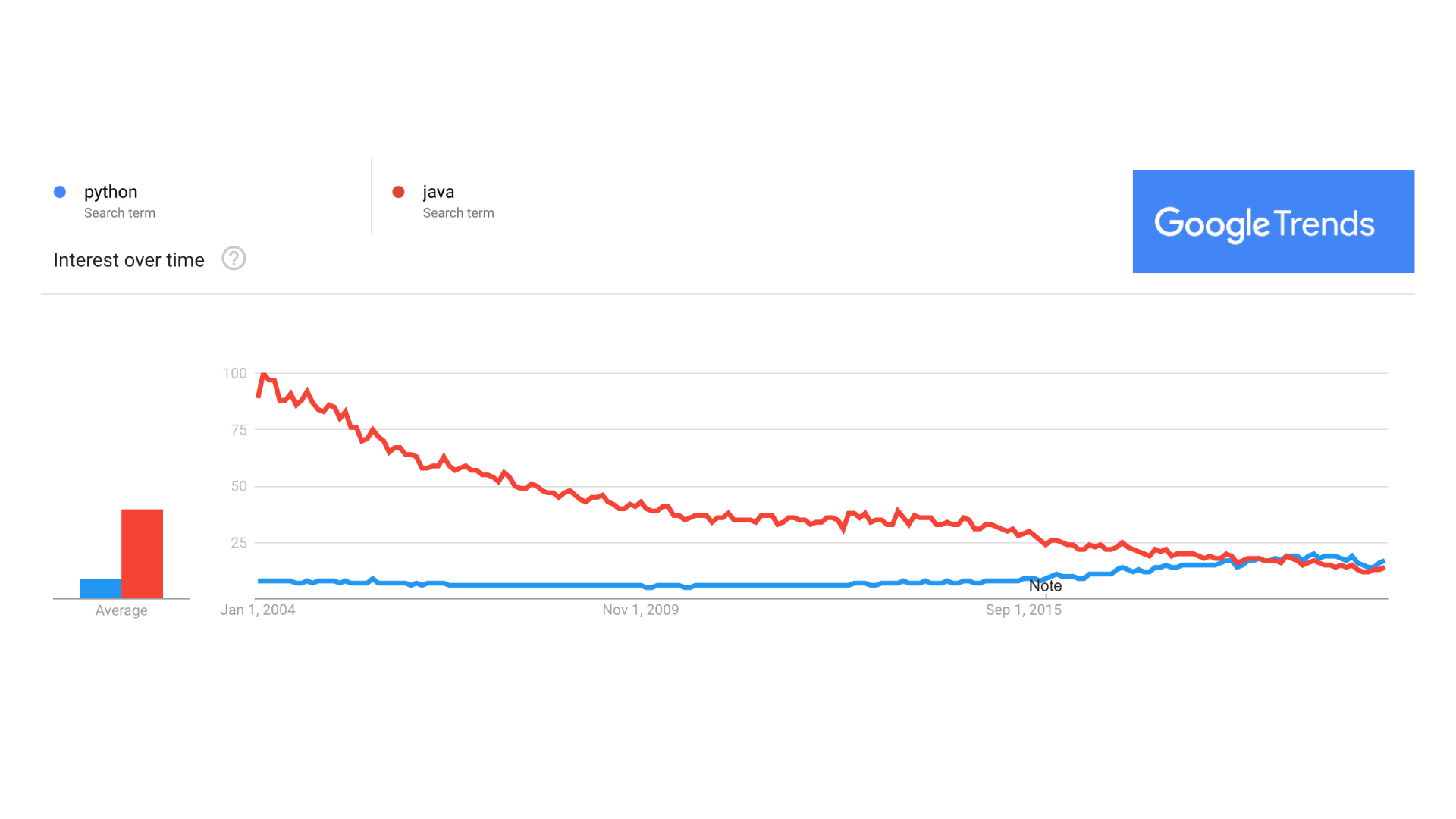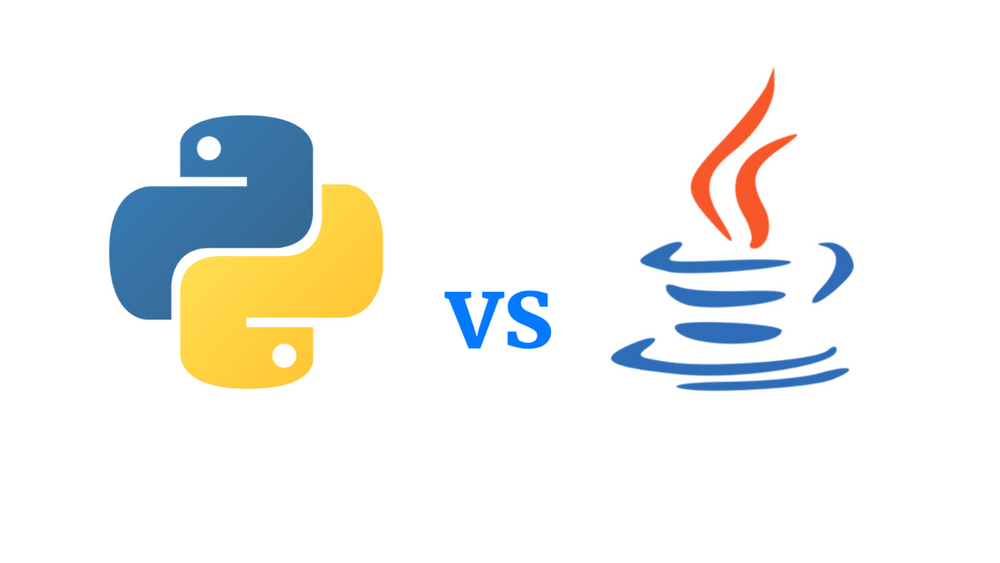Python vs Java: both are excellent and very popular programming languages. Despite their differences, they both stand out for their powerful cross-platform support as well as for their extensive libraries. However, they do excel in different applications.
Before choosing which programming language is better (if there is, in fact, a better one), it is first important to assess their key differences. Therefore, this article will compare both languages based on popularity, syntax, applications, stability, speed, performance, and easiness to learn!
Moreover, in order to fully understand how Python and Java differ from each other, we will also present code examples from both.
Table of Contents
- Introduction to Python
- Introduction to Java
- Python vs Java: comparison table
- Python vs Java: which one is more popular?
- Python vs Java: applications
- Python vs Java: key differences
- Python vs Java: which one to learn
- Python vs Java: which one is better
Introduction to Python
Python was first introduced in 1991. Guido van Rossum developed it at the National Research Institut for Mathematics and Computer Science in the Netherlands.
This dynamically-typed programming language was designed to fulfil general purposes and be highly readable. Dynamically typed means that Python executes type checking at runtime. Its easiness to use makes Python one of the most popular programming languages, thus being often compared with Perl, Ruby, and of course, Java.
Overall, Python is considered a very powerful and clear object-oriented programming language. It is compatible with all operating systems, including Windows, macOS, Unix, and Linux. Plus, Python is free software. Meaning, users can download and use Python for free, and the language can also be redistributed or modified freely since it is available under the GNU General Public License (GPL).
Introduction to Java
Java was developed at Sun Microsystems (later acquired by Oracle) by James Gosling and released in 1995. It is also a general-purpose, object-oriented programming language that is statically typed (perform type checking at compile time). Java was intended to be WORA, which means: write once, run anywhere.
Java is compiled to bytecode, which can run on any JVM (Java Virtual Machine). Therefore, this language is platform-independent since it does not need to be compiled into a specific platform machine. Java's syntax presents similarities to C++ and C; however, it has fewer lower-level facilities.
Python vs Java: comparison table
| Feature | Python | Java |
Language |
Interpreted Language - it can instantly convert human-readable code into machine-readable code. |
Compiled and Interpreted Language - can be considered both since its source code is compiled into a binary bytecode, which in turn runs on the JVM (typically a software based interpreter). |
Typing |
Dynamically typed - Python is an Interpreted Language, dynamically typed. |
Statically typed - Java is a Compiled and Interpreted Language, which is statically typed. |
Popularity |
Slightly more popular, at the moment (2021) - according to GitHub Octoverse, Stackoverflow, and Google Trends Python has a conquered slight popularity advantage over Java. |
Less popular - up until recently, Java was ahead of Python in terms of popularity, but nowadays has less users than Python. |
Applications |
Scientific and numeric computing; Machine Learning applications; image processing; language development. |
Web applications; Desktop GUI Apps; enterprise solutions; embedded systems. |
Syntax |
Less code - the developer does not require to type in the variables since these are input during the runtime; does not need enclosing braces or indentiation rules. |
More code - the developer must type in all the variables and has very rigorous syntax rules. |
Performance |
Compiles the code at runtime, thus being not as agile regarding compilation with every platform. |
Java compiles code in advance and distributes the bytecode. Thanks to Java's static-typing syntax, the compilation is actually faster and easier than Python's dynamic-typing. |
Stability |
Python tests the syntax during the runtime, thus not being as stable as Java despite the fast development. |
Higher stability - Since everything has to be reviewed and established before running, the code must be very well written and, therefore, the software might be more stable and less prone to crashes. |
Speed |
Fast development due to the easiness, simplicity and practicality to write in Python. |
Java projects tend to take longer and may require larger development teams. |
Learning |
Easier to learn - Suitable choice for beginners since its syntax is fairly easy and clear. |
Takes longer to learn - There is a learning curve with a high entry point. |
Python vs Java: which one is more popular?
Python and Java are two powerful competitors fighting for top positions regarding their popularity among programming languages. Truth be told, both languages stand out for their capabilities to handle most computer science tasks. Thus, deciding which one to go for might be tricky!
When it comes to popularity, JavaScript remains the most popular language for the eighth year in a row, according to Stackoverflow's annual survey. However, Python (44.1%) and Java (40.2%) have a very close percentage of users.

Similar results seem to occur regarding GitHub's Octoverse. As we can observe, between 2018 and 2019, Java lost its slight advantage over Python. However, it does not mean that the battle between both languages is over since (to these days) Python has not yet been able to maintain a very significant lead.

Once again, as the image below highlights, we can see that worldwide, we have witnessed an increase in popularity for Python over Java throughout the last years. However, that increase is still very recent considering that up until 2015, Java had a clear advantage.

Python vs Java: applications
Both Python and Java can often be used for Machine Learning and API interactions. However, while on the one hand, Java is often used for enterprise grade applications; on the other hand, Python is excellent for scientific and numeric computing.
Java is a very recognized and used language for web development, being more well-known among senior developers. In addition to handling asynchronous programming, Java is also a very good option for Desktop GUI applications, Enterprise Solutions, Embedded Systems, and web application services. Plus, it has a useful and helpful Natural Language Process community.
Contrarily, Python is very known for its outstanding data processing libraries (e.g., Dask and Pandas), as well as data visualization (e.g., Matplotlib) tools. Thus, it is often used by those interested in entering data science and also by junior developers. Overall, Python provides excellent machine learning libraries, such as PyTorch and TensorFlow, which are both written in this language.
In fact, when it comes to Machine Learning, Python has often been considered a more suitable option since it is syntactically straightforward and offers a vast library package and resources. However, for some, Java is also a compelling option regarding Machine Learning due to its easy debugging and ability to handle large-scale operations and enterprise programs. Plus, developers can also work with Weka, Deeplearning4j and other libraries using Java.
Python vs Java: key differences
Interpreted vs Compiled languages
Python is an interpreted language, meaning it can instantly convert human-readable code into machine-readable code, making it easier to debug and review.
Java is a compiled language. Compiled languages translate source code into machine code before running it.
Syntax
As previously mentioned, Python is a dynamically-typed language, and Java is statically typed. This is the most significant difference between these object-oriented languages since it impacts how the developer writes, designs, and troubleshoots programs.
While typing code, the developer does not require inputting the variables since these are input during the runtime, making Python a very easy and straightforward language. This makes Python also very clear and uncomplicated to read. Another great plus is that this language does not need enclosing braces, and the code blocks are organized according to indentation, making Python very user-friendly and intuitive.
# Declaring variables
x, y = 12, 10
isTrue = True
greeting = "Welcome!"
Contrarily, Java requires the developer to type in all the variables and has very rigorous syntax rules. Whenever there is an error in the code, the program will not run, which can be very frustrating and demotivating, especially for beginners. For instance, while Java takes ten lines of code to read from a file; Python, on the other hand, only requires two lines of code.
public class Main {
public static void main(String[] args) {
// Declaring variables
int x = 12, y = 10;
boolean isTrue = true;
String greeting = "Welcome!";
}
}
Unlike Python (which allows for indentation for writing blocks with multiple lines), Java needs to insert the lines inside of curly brackets to establish and define a method or a block.
Take a look at the following examples comparing Python with Java regarding similar functions:
1. Lists and Arrays
- In Python:
# Working with Lists
countries = [
"Portugal",
"England",
"Brazil",
"New Zealand",
"Spain"
]
numbers = [12, 14, 9, 10, 9]
# Sorting a List
countries.sort()
# Looping a List
for country in countries:
print(country)
- In Java:
import java.util.Arrays;
public class Main {
public static void main(String[] args) {
// Working with Arrays
String[] countries = {
"Portugal",
"England",
"Brazil",
"New Zealand",
"Spain"
};
int[] numbers = {12, 14, 9, 10, 9};
// Sorting an Array in ascending order
// need to import java.util.Arrays
Arrays.sort(countries);
// Looping through an Array
for (String city : countries) {
System.out.println(city);
}
2. Defining a class with constructor and a method
- In Python:
# Defining a class with constructor and a method
class Person:
def __init__(self, name, nationality, age):
self.name = name
self.nationality = nationality
self.age = age
# Declaring a method with if/else statement
# and returning a boolean
def isMinor(self):
if self.age >= 18:
return False
else:
return True
- In Java:
// Defining a class with constructor and a method
public class Person {
String name;
String nation;
int age;
public Person(String name, String nation, int age) {
this.name = name;
this.nation = nation;
this.age = age;
}
public boolean isMinor() {
if (this.age >= 18) {
return false;
}
else {
return true;
}
}
}
3. Instantiate an Object from class person
- In Python:
# Instantiate an Object from class Person
p1 = Person("John Doe", countries[0], 19)
print(p1.isMinor())
- In Java:
// Instantiate an Object from class Person
Person p1 = new Person("John Doe", countries[0], 19);
System.out.println(p1.isMinor());

Performance
Python and Java are cross-platform languages since they both compile bytecode and run it in virtual machines. However, Java compiles code in advance and distributes the bytecode, while Python tends to compile the code at runtime.
Thanks to Java's static-typing syntax, the compilation is actually faster and easier than Python's dynamic typing. Despite the previously mentioned disadvantages, the static-typing syntax is less prone to errors and is more strict regarding the targeted platform, consequently improving code compilation.
Furthermore, Java also provides a JIT (Just-in-time) compiler. This device enables the bytecode to be compiled into the native machine, which allows the compiled code to be called directly. The result? A faster performance.
Python processes code during the compile-time (which is when variables are considered). When the code follows a dynamic-typed syntax, it is not as agile regarding compilation with every platform. Further, as stated, Python tests the syntax during the runtime, meaning that it can keep the whole application on hold if any error occurs with the program. Consequently, both of these factors can lead to reduced language speed and efficiency.
Stability
Unlike Python, Java requires the developer to write according to strict syntax rules and include all the variables. In consequence, there is more code volume, more code to review, and more code to fix. But there is a good side to this! Since everything has to be reviewed and established before running, the code must be very well written and, therefore, the software might be more stable and less prone to crashes.
This is why Java is usually considered the best option for business enterprises such as banks. In fact, Java is often very associated with traditional language for corporations. Nonetheless, Python has also proven to have no trouble handling large-scale software.
To say that Java offers great software stability does not mean that Python is unstable. In comparison, indeed, big companies, such as Android, Docker, and Airbnb, include Java in their tech stack. On the other hand, it is also true that Reddit and even Instagram (Django web framework written in Python) use Python Python as part of their tech stack.
Speed
In Python, the development is incredibly fast due to the easiness, simplicity and practicality to write in this language. When working against the clock, Python is most likely the best solution. However, we cannot say the same about Java regarding development speed. Java projects tend to take longer and may require larger development teams.
In fact, building an MVP (Minimum Viable Product) in Python can be surprisingly fast (in a matter of weeks), while in Java, months would most likely be the case.
Python vs Java: which one to learn?
There is a consensus that Python is a more suitable choice for beginners since its syntax is fairly easy and clear. Plus, Python is a more user-friendly and intuitive language.
Java, in turn, is more complex and challenging. There is a learning curve with a high entry point regarding this language since it takes a lot of time to fully understand how to write in Java and how each API may differ.
It is also argued that Java can lead to higher quality code; however, it is also important to keep in mind that an experienced Python developer can benefit from the same functionalities as in Java.
Ideally, an outstanding developer would benefit greatly from learning both languages. As we have previously observed, Python and Java excel at different applications. To begin coding, Python might be easier to learn, but Java is far from being impossible; it just takes longer.
Python vs Java: which one is better?
Which is better, Python or Java? Python's simplicity and readability make it great for beginners and rapid development, while Java's static-typing and object-oriented features make it ideal for large scale applications. The "better" choice depends on your project requirements and personal preference.
Although Python is expected to run slower than Java, it also takes less time to develop. Due to the built-in high-level data type, as well as dynamic typing, Python is usually shorter than equivalent Java programs, thus being more straightforward and faster to develop.
Since Java requires more code and everything needs to be pre-defined, developers also need more time to review everything and fix potential errors. Naturally, the more code there is, the more complex it gets. Nonetheless, the rigour it takes to write the code well can also result in a more stable and robust software.
Simply put, Python runs slower but launches faster. Contrarily, Java launches slower but stands out for running faster. Ultimately, the better programming language is the one that meets the type of software program the developer wishes to create. Ideally, as referred, developers would benefit from learning both languages.
Conclusion
After carefully analyzing the programming languages, it is no surprise that both Python and Java are in the top languages used worldwide. Python stands out for its simplicity and practicality, making development less complex. On the other hand, Java is not as simple to use, but it does offer outstanding stability and is a great way for the developer to apply computer science fundamentals.
Plus, as we have observed, Python programs are typically shorter than the equivalent programs in Java due to Python's dynamic typing as well as the built-in high-level data types. However, Java is faster at runtime and also easier to debug.
In short, both languages provide so many advantages that together they would make an outstanding combination!




